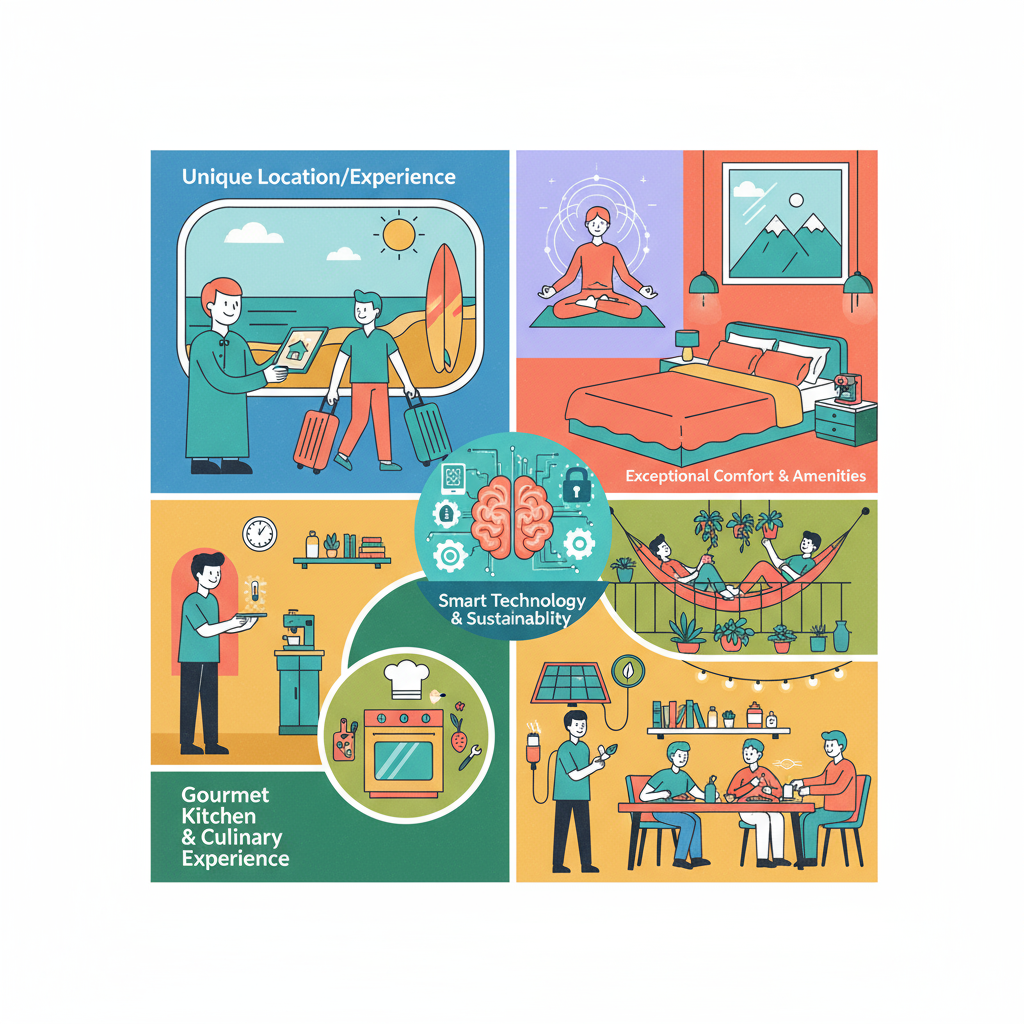Key Takeaways
You can maintain strong bookings during Airbnb's off-season—which usually lands in January through March and then again in late spring before summer travel picks up—by adapting your strategy rather than lowering standards.
Boost occupancy during slow periods with flexible check-in options, last-minute availability, and strategic length-of-stay discounts.
Attract remote workers and value-seeking travelers by showcasing your property's work-friendly amenities and off-season advantages.
Off-season periods can drain momentum from even the most promising short-term rental (STR) business.
When bookings slow, pricing pressures rise and high fixed costs start to burn through margins. For new hosts managing just a few properties, this seasonal dip can feel like a major setback.
The good news is that the Airbnb off-season doesn’t have to mean lost revenue. With a smart approach to seasonal pricing and a few low-lift adjustments to your calendar and policies, you can stay competitive in slower months and still attract quality guests. Strategies like extended stay discounts, flexible check-in policies, and targeting remote workers help maintain visibility and boost occupancy in periods when demand naturally dips.
According to the Airbnb Resource Center, properties that offer flexible cancellation and check-in policies show improved search performance and higher booking conversion during the Airbnb slow season. For newer hosts especially, those adjustments can make the difference between an idle listing and a fully booked calendar.
Smart Tactics to Boost Occupancy
When bookings slow, speed and flexibility matter more. Many off-season guests wait until the last minute to make decisions. Shortening your advance notice window helps catch those spontaneous travelers before they book somewhere else.
Opening your calendar to allow reservations with only a few hours' notice puts your listing in front of people looking for immediate options. Remote workers extending a trip, locals planning a quick weekend reset, or families adjusting travel plans all fall into this category. If your calendar blocks last-minute stays, you’re missing easy wins.
Smart pricing beats manual adjustments every time. Rate tools that update based on demand, booking window, and local activity help you stay competitive without constant tweaking. Setting a low base rate for off-season nights, then layering in rules for last-minute discounts, keeps your pricing realistic and responsive. A same-day 15% drop can fill a night that would otherwise sit empty.
Use shorter stays
One- and two-night minimums open the door to travelers booking quick getaways.
These shorter bookings fill calendar gaps between longer stays and increase your visibility in search results. Short stays also appeal to guests who don’t want to commit to a full weekend or longer trip.
Quick turnovers only feel overwhelming when cleaning and scheduling aren’t handled automatically. Set up systems to assign cleaning jobs based on check-outs, and make sure calendar updates sync in real time across all booking platforms. That way, back-to-back bookings don’t mean extra stress.
Add a custom promotion
Longer stays are easier to sell when they come with a built-in incentive. Weekly discounts around 10–15%, and deeper price cuts for 28+ night bookings, attract guests who want a slower pace and fewer transitions. Travelers booking during slower periods often look for flexibility, comfort, and value over flashy amenities.
Set up pricing rules that apply discounts based on stay length or booking window. For example, apply a 20% rate drop for any stay longer than 7 nights that starts within the next three days. That kind of smart targeting fills gaps and encourages longer reservations without manual input.
Certain restrictions make sense in high season when demand is strong and you can afford to be picky. But too many barriers in the off-season can turn away solid bookings. Policies like “no same-day check-in,” “must arrive before 6 p.m.,” or “guests must be 25+” shrink your audience for no good reason.
Lighten up where it makes sense. Use smart locks with auto-expiring codes, require verified ID, and set up noise monitors to flag issues before they escalate. These tools help you stay in control without scaring off responsible guests. The goal isn’t to lower standards—it’s to stop turning away travelers who just want a smooth, last-minute stay.
All-in-one Vacation Rental Software and Channel Management System
Get started in seconds by connecting Airbnb
Manage short-term rentals & bookings, message guests, take payment, and so much more. All in one easy-to-use platform (that never double-books).
Attract Remote Workers and Extended-Stay Guests
When weekend travelers disappear, remote professionals keep booking. They’re not chasing festivals or school holidays, they’re just looking for quiet places to work, stay longer, and stretch their budgets. The Airbnb off-season gives them lower prices and more availability, and that’s exactly what makes your listing more appealing if it’s set up for flexible, extended stays.
Guests working from your property care about more than just square footage or style. They want comfort, reliable tech, and a space that helps them stay productive without distractions. A listing that clearly supports work-from-anywhere lifestyles stands out fast, especially during slower booking periods.
Offer work amenities
Set up a space meant for getting work done, not just checking emails from the couch. A basic desk and chair won’t cut it if they’re wobbly or tucked into a dark corner. Use a real desk, pair it with an ergonomic chair, and highlight fast, stable Wi-Fi with actual upload and download speeds.
Add strong lighting. A desk lamp or adjustable task light helps with long hours. Quiet surroundings are just as important. Mention anything that helps reduce noise: solid doors, rugs, or even white noise options. If space is tight, a compact workstation or wall-mounted desk still works as long as it’s well thought out.
Skip vague descriptions like “great for working remotely.” Be specific. Say what’s included, where it’s located, and how it supports longer stays.
Provide local perks
Travelers staying for a week (or a few) don’t want to guess where to find good coffee or a place to stretch their legs. Offer a short guide that lists quiet cafés, nearby coworking spots, and places with strong Wi-Fi. Include off-season activities guests can enjoy on weekdays, like hiking trails, bike rentals, or happy hour deals.
Even better, reach out to a local café or coworking space and set up a simple discount for your guests. A free coffee or a few dollars off a coworking pass makes your place stand out without much extra work. Include printed cards or QR codes so guests get access without messaging you every time.
Flexible check-in and check-out helps too. Remote workers often book last-minute or extend their stay by a few days. Let guests check in late or leave early without hassle, and they’re more likely to choose your property over one with stricter rules.

Action Steps for Revenue Growth
Revenue doesn’t grow on its own—especially when travel slows.
The Airbnb off-season tends to catch newer hosts off guard, but it’s actually a great time to tighten operations and test smart strategies. Automating your pricing and syncing calendars across every booking site gives you a real edge. Rates adjust instantly based on demand, and availability stays accurate across platforms without constant updates.
Try small changes and watch how they perform. Adjust minimum stay rules. Offer mid-week discounts. Run last-minute deals. Review results monthly. If something doesn’t help, drop it. If a tweak fills gaps, keep it going. The more you experiment and measure, the faster you’ll find out what actually brings in more bookings.
The “Flexible Dates” feature helps your property show up for travelers who aren’t tied to specific check-in days. Remote workers and long-stay guests use this option to find value-driven stays when prices are lower. If your calendar isn’t open far enough or synced correctly, you’ll miss the traffic coming in through flexible-date searches.
Try automation
Manual work eats your time fast. Responding to the same guest questions, coordinating cleaners, and adjusting calendars every day turns into a full-time job.
Automating guest messages and cleaning tasks cuts out those repetitive steps. Pre-set messages handle check-in instructions, reminders, and reviews. Cleaning gets scheduled automatically after each check-out, so you don’t chase your team with texts or emails.
With those tasks off your plate, you can focus on pricing, guest experience, and planning for the next quarter—work that actually grows your business.
Leverage direct booking
Direct booking gives you more control, higher profits, and fewer OTA fees. Run offers on your own site—like discounts on longer stays or free early check-in for return guests—and keep 100% of the payout. That kind of flexibility builds loyalty and keeps bookings steady when demand dips.
A good property management system connects your direct bookings to your master calendar, guest messaging, and cleaning schedule.
Navigating the Airbnb off-season successfully comes down to being proactive and flexible. By optimizing your calendar settings, offering strategic discounts, and automating routine tasks, you can keep occupancy high and reduce stress when demand slows. Positioning your property for remote workers and long-stay travelers gives you a competitive edge that lasts beyond the peak season.
Every slow period is also a chance to tighten operations, build guest loyalty, and test revenue strategies that scale. With the right systems in place, you’re not just surviving the off-season—you’re using it to strengthen your business for the long haul.
Sign up for Uplisting to streamline your vacation rental management. Our all-in-one platform helps you automate pricing, manage operations, and deliver exceptional guest experiences year-round.
Create 5-star guest experiences
Give your guests unforgettable experiences
With Uplisting, you can send the right messages at the right time on all booking sites. Read and respond to guest messages in a single, unified inbox — whether you’re at the office or on the go.
FAQs About Airbnb Off-Season
What is the slow season for Airbnb?
The Airbnb off-season usually lands right after the holidays—January through March in most areas—and again in late spring before summer travel picks up. In some regions, it lines up with lulls in local tourism, like hurricane season near the coast or mud season in mountain towns. Every market has its quiet stretches, but the pattern stays familiar: fewer bookings, more price drops, and increased competition for travelers.
What is the cheapest time to book an Airbnb?
Rates often dip when demand thins. Mid-week stays, shoulder seasons, and last-minute reservations usually come with lower prices. Hosts drop rates to fill nights that would otherwise sit empty, especially when check-in is within a day or two. Travelers willing to adjust their timing a bit can find serious savings without much effort.
What is the 80/20 rule for Airbnb?
When bookings slow down, the 80/20 rule becomes more obvious. Around 20% of your pricing rules, listing adjustments, or calendar settings often drive 80% of your bookings. Instead of tweaking every detail, double down on the few tactics that already bring in reservations (like weekly discounts or short-notice booking windows) and skip the ones that don’t make a difference.
How to get a 20% discount on Airbnb?
Hosts often set automatic discounts for weekly or monthly stays, especially during the Airbnb off-season. Same-day or next-day bookings also tend to be cheaper, since those open nights are harder to fill. Some hosts are open to direct offers on longer stays, even if the discount isn’t listed. Reaching out with a quick, polite message can lead to a better rate.

















.png)

